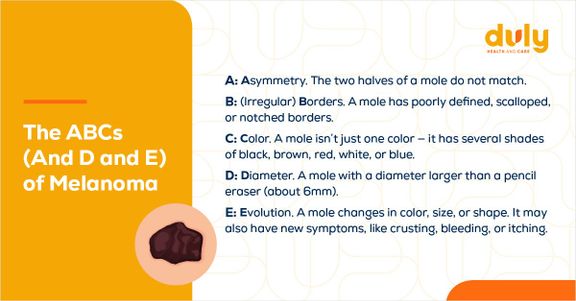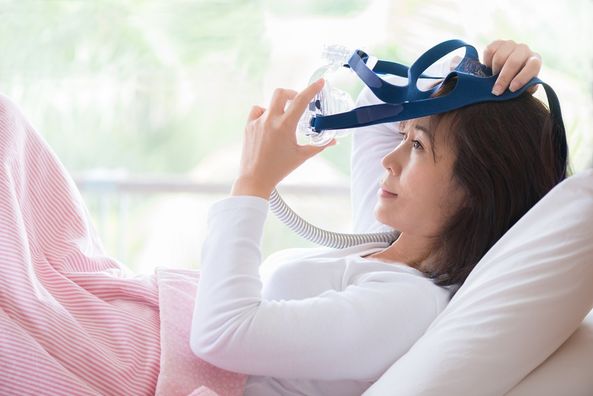You’ve heard it before: Spending too much time in the sun without sunscreen or using tanning beds can cause skin cancer. These may be common risk factors you’ve heard often, and that’s because the majority of skin cancers are caused by overexposure to ultraviolet (UV) rays, which come from the sun, tanning beds, and sunlamps.
While these causes of skin cancer are often well known, you may not know as much about melanoma, a rarer form of skin cancer. Melanoma only accounts for about 1% of skin cancer cases — but it is responsible for the majority of skin cancer deaths. And while exposure to UV rays is a major risk factor for melanoma, it’s not the only one.
Also read, “Where Can Melanoma Be Hiding on My Body?”
If you are concerned about melanoma, contact a Duly Health and Care dermatologist.
Here are 9 other surprising melanoma risk factors.
1. Fair Skin, Fair Game for Melanoma. 1 in 38 White people will get melanoma at some point in their life, while only 1 in 1,000 Black people will get it. That makes it more than 20 times more common among White people than Black people. People with dark skin have higher amounts of melanin (what gives skin and eyes their color), which protects the skin from the sun’s ultraviolet rays.
2. There’s an Eye-Opening Truth: Having blue or green eyes may increase your likelihood of developing an eye cancer called uveal melanoma. While the exact reason is still not 100% clear, there is evidence of an association between the genes linked to eye color and to developing uveal melanoma.
3. It Runs in the Family. About 10% of people with melanoma have a family member who has or has had melanoma. There are multiple factors that might be the cause of this risk, such as genetic mutations, similar shades of skin, or shared experiences with sun exposure.
4. The Number of Candles On Your Cake Matters. Being over age 50 increases your risk of melanoma, and the average age of diagnosis is 65. But that doesn’t mean that younger people aren’t at risk.
- Melanoma is the third most common cancer in adults ages 15 – 29.
- Young women under age 30 are 6 times more likely to develop melanoma if they tan indoors.
- Sunburns during younger ages can increase your risk of developing melanoma later in life. It only takes five blistering sunburns between ages 15 and 20 to increase your risk of melanoma by 80%.
5. The Risk Changes With Age and Sex. In the US, the risk of melanoma is higher for women before 50, but higher for men after age 50.
6. Around 20 to 30% of Melanomas Develop From Existing Moles. Having 50+ moles, having a very large mole, or having atypical moles (more than one color, jagged border, or not perfectly round) puts you at higher risk for melanoma.
7. Your Immune System Affects Your Melanoma Risk. A condition like HIV or taking medication after an organ transplant that weakens your immune system may make you as much as 6 times more likely to develop melanoma.
8. Your Medical History Makes a Difference. A history of certain conditions can increase your risk for melanoma, including:
- Skin, breast, or thyroid cancer
- Hereditary Breast and Ovarian Cancer Syndrome (HBOC)
- Other inherited conditions, like xeroderma pigmentosum (extreme sun sensitivity), Werner syndrome (premature aging), or retinoblastoma (cancer that forms in the back of your eye, most common among children)
9. You Have Tattoos — Especially Large Ones. While not exactly a risk factor for melanoma itself, it is a risk factor for not noticing melanoma until it’s in a later stage. Tattoos that cover large portions of your skin can make it hard to see changes in moles under the ink.
Spotting Melanoma
Almost all adults have a few moles, and most moles are harmless. But there are several warning signs that a mole might actually be a sign of skin cancer.
Since May is Melanoma Awareness Month, it’s a good time to become more familiar with the signs of melanoma by remembering the ABCDE method:

Source: Skin Cancer Foundation
The “E” (Evolution) is the most important ABCDE to look for when performing a self-skin examination. Moles that change in color, symmetry, or size are often the first signs of melanoma.
Additionally, you may be able to spot melanoma using the “Ugly Duckling” method. If a mole doesn’t necessarily fit into the ABCDEs, but looks different than the other moles on your body, it should also be checked by a dermatologist.
If you notice any of these signs, or have concerns about melanoma or skin cancer in general, reach out to your Duly Health and Care dermatologist.
Health Topics:








